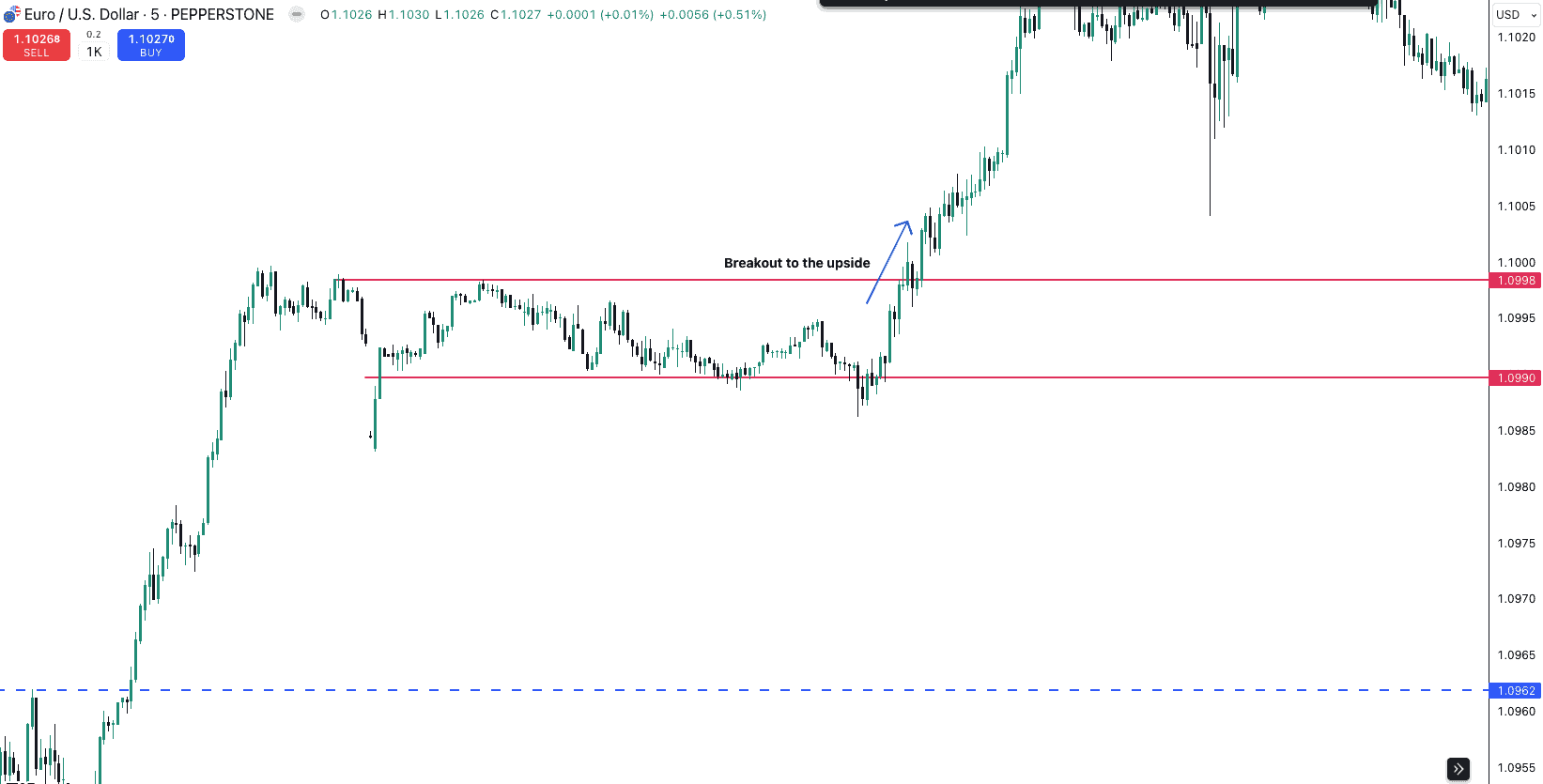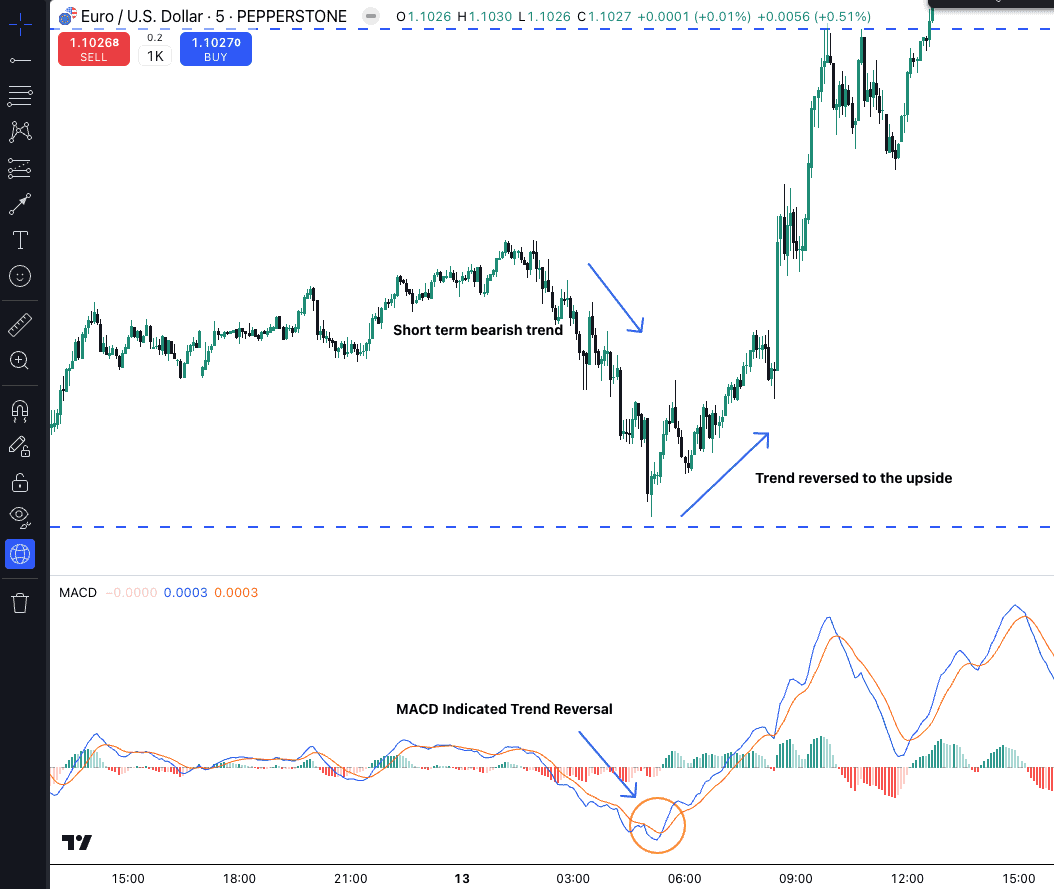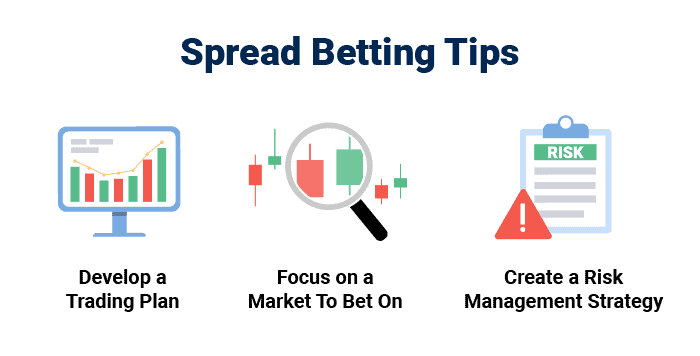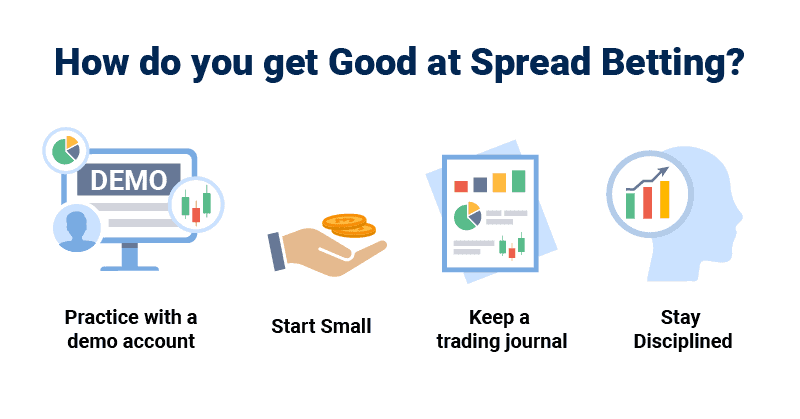Spread betting is a high-risk, potentially lucrative way to speculate on financial markets. Success requires a solid strategy, disciplined risk management, and diligent market analysis. In this article, I’ve gathered the best spread betting tips and strategies with spread betting examples that you can use to improve your chances of success.
Best Spread Bet Strategies
To succeed with spread betting, you must have a strategy for finding betting opportunities. The benefits of a strategy are that it allows you to eliminate variables and blindly jump on trades while allowing you to find profitable trades based on your rules consistently. There are many spread betting strategies, but below are some of the most popular types:
1. Breakout spread bet strategies
Breakout trading is a popular strategy among spread bettors who tend to prefer day trading. It aims to capitalise on significant price movements that occur when a currency pair breaks through a key support or resistance level. The idea behind this strategy is that when a breakout occurs, the price will likely continue moving in the same direction, providing an opportunity for profitable trades.
How to Trade Breakouts
- Identify key support and resistance levels using technical analysis tools like trend lines, moving averages, or Fibonacci retracements.
- Wait for the price to break above resistance (for a bullish breakout) or below support (for a bearish breakout).
- Look for confirmation of the breakout, such as a closing price above or below the key level.
- Place a spread bet in the direction of the breakout (buy for bullish, sell for bearish).
- Set a stop-loss order to limit potential losses if the trade goes against you.
- Consider taking profit at predetermined levels, such as the next key support or resistance level.
It’s important to note that false breakouts can occur, where the price briefly breaks through a level but then reverses direction. To mitigate this risk, you can wait for confirmation of the breakout, such as a closing price above or below the key level, before entering a trade. You can also use stop-loss orders to limit your potential losses if the trade doesn’t go as planned.
Bullish Breakout Example
If the price breaks above a key resistance level, the market may continue to increase. As you can see in the example below, the market closed above the 1.0998 level and continues to run higher, making this a bullish breakout.

Bearish Breakout Example
If the price breaks below a key support level, the market may continue to decline. As you can see in the example below, the market closed below 1.0926 and continued lower, making it a bearish breakout.
Reversal spread betting strategies
Reversal trading is another popular strategy among spread bettors, which involves identifying potential turning price points in the market where the price is likely to change direction. This strategy can be effective in markets ranging or experiencing temporary pullbacks within a larger trend, allowing you to enter and profit from the prevailing trend.
- Identify potential reversal patterns, such as head and shoulders, double tops/bottoms, or wedges.
- Look for signs of trend exhaustion, such as divergences between price and momentum indicators like RSI or MACD.
- Wait for confirmation of the reversal, such as a break of a key support or resistance level in the opposite direction of the current trend.
- Place a spread bet in the opposite direction of the current trend (sell for a bearish reversal, buy for a bullish reversal).
- Set a stop-loss order to limit potential losses if the reversal doesn’t materialise.
- Consider taking profit at predetermined levels, such as the next key support or resistance level in the new trend direction.
Once you’ve identified a potential reversal point, you can place a spread bet in the opposite direction of the current trend, anticipating that the price will change direction. Using stop-loss orders to limit your potential losses if the reversal doesn’t materialise as expected is important. Below is an example of a reversal trade:

| Reversal Pattern | Description | Example |
|---|---|---|
| Head and Shoulders | A chart pattern that indicates a potential bearish reversal | If EUR/USD forms a head and shoulders pattern at a key resistance level, it may indicate a potential sell opportunity |
| Double Top | A chart pattern that indicates a potential bearish reversal | If GBP/USD forms a double-top pattern at a key resistance level, it may indicate a potential sell opportunity |
| Double Bottom | A chart pattern that indicates a potential bullish reversal | If USD/JPY forms a double bottom pattern at a key support level, it may indicate a potential buy opportunity |
2. Scalping spread bet strategies
Scalping is a short-term trading strategy that involves making multiple trades over a short period to profit from small price movements. This strategy can be effective in volatile spread betting markets with frequent price fluctuations.
- Choose forex pairs with high liquidity and volatility, such as EUR/USD or GBP/USD.
- Use short-term charts, such as 1-minute or 5-minute timeframes, to identify potential trading opportunities.
- Look for short-term price patterns, such as support and resistance levels or candlestick patterns.
- Place multiple short-term trades in the direction of the identified patterns, with small profit targets and strict stop-losses.
- Close trades quickly to minimise exposure to market risk and to lock in profits.
- Maintain a disciplined approach to risk management, limiting exposure to any single trade and using stop-loss orders consistently.
- Consider using automated trading systems to help execute trades quickly and efficiently.
Scalping requires a high degree of discipline and risk management, as the potential losses can quickly add up if trades go against you. You may also consider using automated trading systems to help you execute trades quickly and efficiently.
Spread Betting Advice
Spread betting can be a lucrative way to speculate on financial markets, but it also comes with significant risks. To increase your chances of success and minimise your potential losses, it’s important to follow some key spread betting tips.
1. Develop a Trading Plan
One of the most important things you can do to improve your chances of success in spread betting is to develop a solid trading plan. Your trading plan should outline your strategies for entering and exiting trades.
Spread betting can be a high-risk activity, and it’s important only to bet what you can afford to lose, so you must set your risk tolerance to help protect your funds. Set strict limits on the amount you’re willing to risk on each trade and stick to those limits no matter what.
You should develop a set of rules for entering and exiting trades based on your market analysis and overall trading strategy. For example, you may decide only to enter trades when certain technical indicators give a bullish signal, or you may have a rule always to use stop-loss orders to limit potential losses.
2. Focus on a Market To Bet On
Another key tip for successful spread betting is to focus on a specific market or set of markets. Trying to trade too many different markets at once can be overwhelming and lead to poor decision-making or chasing trades.
When choosing a market to focus on, consider factors such as your level of knowledge and experience, the volatility and liquidity of the market, and the potential for profitable trades. Many spread bettors choose to focus on forex markets, as they offer high liquidity and volatility and the ability to trade 24 hours a day, five days a week.
Once you’ve chosen a market to focus on, take the time to research and analyse it thoroughly while using an economic calendar to monitor data releases. Look for patterns and trends that could indicate potential trading opportunities and develop a deep understanding of the factors that drive price movements in that market.
3. Create A Risk Management Strategy
Risk management is perhaps the most important aspect of successful spread betting. No matter how good your trading strategy is, there will always be losing trades, and it’s crucial to have a plan in place to limit your potential losses.
One of the most effective risk management tools is the stop-loss order. A stop-loss order is a pending order to your broker to automatically close out your trade if the market moves against you by a certain amount. By using stop-loss orders, you can limit your potential losses on each trade and protect your overall trading capital.
Another crucial risk management practice is limiting your position size. You should base this on your total account balance to protect your capital. By betting smaller, more manageable amounts, you reduce the risk of wiping out your account. A common rule of thumb is to risk only 1-3% of your total account per spread bet. This approach means you’d need an incredibly unfortunate streak of 33 to 100 consecutive losses to deplete your account, assuming you have a solid strategy.

How do you get good at spread betting?
Becoming a successful spread bettor requires a combination of knowledge, skill, and discipline. Here are some tips to help you get good at spread betting:
Practice with a demo account
All UK spread betting platforms include a demo account that allowing you to practice trading with virtual money in a risk-free trading environment. Take advantage of these accounts to test your strategies and get comfortable with the trading platform before risking real money.
Start small
When starting out, it’s important to keep your bets small and focus on building your skills and confidence. Don’t risk more than you can afford to lose, and avoid the temptation to chase losses or double down on losing trades.
Keep a trading journal
Keeping a detailed record of your trades can help you identify patterns and improve your performance over time, this is something that transformed my trading. Note down the details of each trade, including the market, entry and exit points, and the outcome. Review your journal regularly to identify areas for improvement and refine your trading strategy.
Stay disciplined
Successful spread betting requires a high degree of discipline and emotional control. Avoid letting your emotions guide your trading decisions, and stick to your trading plan even when things aren’t going your way. Don’t chase losses or take excessive risks in an attempt to make up for previous losses.

How to win a spread bet?
Winning a spread bet requires a combination of skill, knowledge, and discipline. Here are some tips to help you increase your chances of success:
- Do your research: Before placing a spread bet, make sure you have a thorough understanding of the market you’re trading and the factors that drive price movements. Use fundamental and technical analysis to identify potential trading opportunities and assess the risks involved.
- Manage your risk: Spread betting can be a high-risk activity, and managing your risk carefully is important. Only bet what you can afford to lose, and avoid the temptation to chase losses or double down on losing trades. Use proper position sizing and diversify your trades across multiple markets to spread your risk.
- Be patient: Successful spread betting often requires patience and discipline. Don’t feel pressured to make trades just for the sake of being active in the market. Wait for high-quality trading opportunities that align with your strategy, and be willing to hold onto profitable trades for as long as necessary.
What are the best practices for managing risk in financial spread betting?
Managing risk is crucial for success in financial spread betting. Here are some best practices to help you minimise your potential losses:
- Set stop-loss orders to limit potential losses
- Use take-profit orders to secure gains
- Only risk a small percentage of your capital per trade
- Stay informed about market news and trends
- Practice with a demo account before using real money
- Develop and stick to a trading plan
- Never bet more than you can afford to lose
What are the best indicators for successful spread betting on financial markets?
Spread bettors use many different indicators to analyse financial markets to help find new trading ideas. Here are some of the most popular and effective indicators:
| Rank | Indicator | Description | Optimal Strategies |
|---|---|---|---|
| 1 | Moving Averages | A powerful tool for identifying trends and potential support and resistance levels | Breakout and Trend-following |
| 2 | Bollinger Bands | A volatility indicator with a moving average and two standard deviation bands | Breakout and Reversal |
| 3 | MACD | Shows the relationship between two moving averages, indicating momentum shifts | Breakout and Trend-following |
| 4 | Relative Strength Index (RSI) | Measures price movement speed and change, identifies overbought/oversold conditions | Reversal |
| 5 | Stochastic Oscillator | Compares closing price to price range to identify overbought/oversold conditions | Scalping and Reversal |
| 6 | Fibonacci Retracements | Indicates potential support and resistance levels based on key Fibonacci ratios | Trend-following and Reversals |
It’s important to note that no single indicator is perfect, and it’s often best to use a combination of indicators to confirm trading signals. Additionally, it’s crucial to backtest any indicators or strategies on a demo account for forward testing or historical data for backtesting before using them in live trading.
FAQs
What is spread betting in forex?
Spread betting in forex involves speculating on currency pairs’ price movements without owning the underlying currencies. You place a bet on whether you think the market price of a currency pair will rise or fall, and your profit or loss is determined by the size of your bet and the actual price movement.
How can I trade on a Forex spread betting platform?
To trade on a forex spread betting platform, you must open an account with a spread betting provider. Look for a reputable provider with competitive spreads, a user-friendly platform, and robust risk management tools. Once your account is set up, you can choose the currency pairs you want to trade, decide on your trade size and direction, and place your bets using the desktop or spread betting app interface.
Best Spread Betting Strategy For Beginners
For beginner bettors, a simple and effective spread betting strategy focuses on trending markets and uses a combination of technical indicators, such as moving averages and RSI, to identify potential entry and exit points. It’s also important to start with small bet sizes, use stop-loss orders to limit potential losses, and never risk more than you can afford to lose. As you gain experience and confidence, you can gradually expand your strategies and risk exposure.
Is spread betting profitable?
Spread betting can be profitable, and many bettors use this method of speculating to grow their capital. Consistently profitable spread bettors typically have a deep understanding of the markets, a well-defined strategy, and disciplined risk management. Like any form of trading or investing, there are no guarantees of success, and it’s possible to lose money and make money. View our statistics page to get a better understanding of financial spread betting.
What is the formula for spread betting?
The formula for calculating the profit or loss from a spread bet depends on the trade’s specific details, including the bet’s size and the underlying asset’s price movement.
In general, the formula for calculating the profit or loss from a spread bet can be expressed as:
Profit/Loss = (Closing Price – Opening Price) x Stake Size
Where:
- Closing Price is the price of the asset when the bet is closed
- Opening Price is the price of the asset when the bet is opened
- Stake is the amount of money bet per point of movement in the asset price
Is Spread Betting Legal?
In England, spread betting is legal and regulated by the Financial Conduct Authority, headquartered in London (similar financial regulations as CFDs). The FCA has implemented rules for spread betting firms to protect retail investor accounts, such as segregating client accounts and following strict conduct standards. Spread betting is considered gambling for tax purposes, qualifying for exemption from capital gains tax, a benefit of spread betting over CFD trading. Learn more about the FCA on our regulation page.



Ask an Expert
What is the most important tip for beginners in spread betting?
The most important tip is to start small and understand the risks involved before committing significant capital.
How can I manage risk effectively when spread betting?
Managing risk involves setting stop-loss orders, limiting leverage, and keeping trades small relative to your account size.